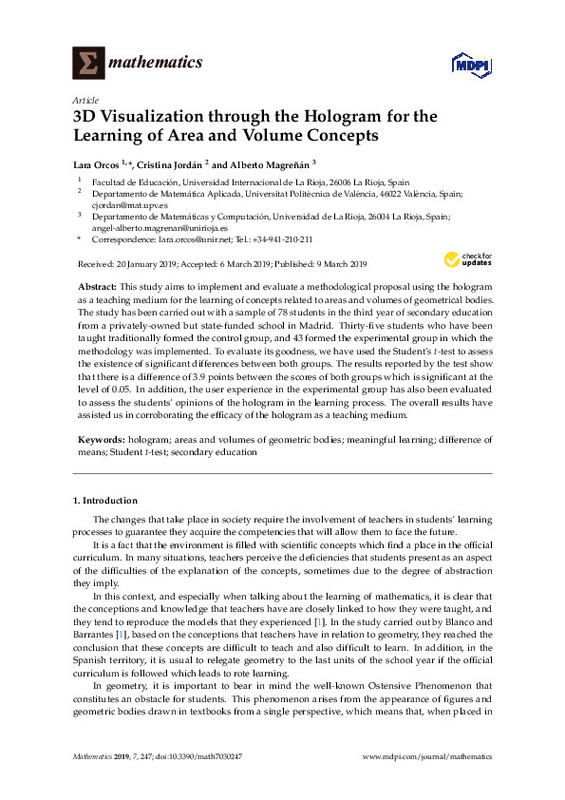JavaScript is disabled for your browser. Some features of this site may not work without it.
Buscar en RiuNet
Listar
Mi cuenta
Estadísticas
Ayuda RiuNet
Admin. UPV
3D Visualization through the Hologram for the Learning of Area and Volume Concepts
Mostrar el registro sencillo del ítem
Ficheros en el ítem
| dc.contributor.author | Orcos, Lara
|
es_ES |
| dc.contributor.author | Jordan-Lluch, Cristina
|
es_ES |
| dc.contributor.author | Magreñán, Alberto
|
es_ES |
| dc.date.accessioned | 2021-01-19T04:32:35Z | |
| dc.date.available | 2021-01-19T04:32:35Z | |
| dc.date.issued | 2019-03-09 | es_ES |
| dc.identifier.uri | http://hdl.handle.net/10251/159359 | |
| dc.description.abstract | [EN] This study aims to implement and evaluate a methodological proposal using the hologram as a teaching medium for the learning of concepts related to areas and volumes of geometrical bodies. The study has been carried out with a sample of 78 students in the third year of secondary education from a privately-owned but state-funded school in Madrid. Thirty-five students who have been taught traditionally formed the control group, and 43 formed the experimental group in which the methodology was implemented. To evaluate its goodness, we have used the Student's t-test to assess the existence of significant differences between both groups. The results reported by the test show that there is a difference of 3.9 points between the scores of both groups which is significant at the level of 0.05. In addition, the user experience in the experimental group has also been evaluated to assess the students' opinions of the hologram in the learning process. The overall results have assisted us in corroborating the efficacy of the hologram as a teaching medium. | es_ES |
| dc.description.sponsorship | This work was supported in part by Programa de Apoyo a la investigacion de la fundacion Seneca-Agencia de Ciencia y Tecnologia de la Region de Murcia 19374/PI/14, by the project MTM2014-52016-C2-1-P of the Spanish Ministry of Science and Innovation. | es_ES |
| dc.language | Inglés | es_ES |
| dc.publisher | MDPI AG | es_ES |
| dc.relation.ispartof | Mathematics | es_ES |
| dc.rights | Reconocimiento (by) | es_ES |
| dc.subject | Hologram | es_ES |
| dc.subject | Areas and volumes of geometric bodies | es_ES |
| dc.subject | Meaningful learning | es_ES |
| dc.subject | Difference of means | es_ES |
| dc.subject | Student t-test | es_ES |
| dc.subject | Secondary education | es_ES |
| dc.subject.classification | MATEMATICA APLICADA | es_ES |
| dc.title | 3D Visualization through the Hologram for the Learning of Area and Volume Concepts | es_ES |
| dc.type | Artículo | es_ES |
| dc.identifier.doi | 10.3390/math7030247 | es_ES |
| dc.relation.projectID | info:eu-repo/grantAgreement/f SéNeCa//19374%2FPI%2F14/ | es_ES |
| dc.relation.projectID | info:eu-repo/grantAgreement/MINECO//MTM2014-52016-C2-1-P/ES/ECUACIONES NO LINEALES Y METODOS ITERATIVOS. APLICACIONES A PROBLEMAS DE OPTIMIZACION Y ECUACIONES MATRICIALES./ | es_ES |
| dc.rights.accessRights | Abierto | es_ES |
| dc.contributor.affiliation | Universitat Politècnica de València. Departamento de Matemática Aplicada - Departament de Matemàtica Aplicada | es_ES |
| dc.description.bibliographicCitation | Orcos, L.; Jordan-Lluch, C.; Magreñán, A. (2019). 3D Visualization through the Hologram for the Learning of Area and Volume Concepts. Mathematics. 7(3):1-20. https://doi.org/10.3390/math7030247 | es_ES |
| dc.description.accrualMethod | S | es_ES |
| dc.relation.publisherversion | https://doi.org/10.3390/math7030247 | es_ES |
| dc.description.upvformatpinicio | 1 | es_ES |
| dc.description.upvformatpfin | 20 | es_ES |
| dc.type.version | info:eu-repo/semantics/publishedVersion | es_ES |
| dc.description.volume | 7 | es_ES |
| dc.description.issue | 3 | es_ES |
| dc.identifier.eissn | 2227-7390 | es_ES |
| dc.relation.pasarela | S\407552 | es_ES |
| dc.contributor.funder | Fundación Séneca-Agencia de Ciencia y Tecnología de la Región de Murcia | es_ES |
| dc.contributor.funder | Ministerio de Economía y Competitividad | es_ES |
| dc.description.references | Toledo, R. S., Cruz, G. V., Zaldo, A. F., Lunazzi, J. J., & Magalhães, D. S. F. (2009). El holograma y su utilización como un medio de enseñanza de la física en ingeniería. Revista Brasileira de Ensino de Física, 31(1), 1401.1-1401.12. doi:10.1590/s1806-11172009000100007 | es_ES |
| dc.description.references | Orcos, L., & Magreñán, Á. A. (2018). The hologram as a teaching medium for the acquisition of STEM contents. International Journal of Learning Technology, 13(2), 163. doi:10.1504/ijlt.2018.092097 | es_ES |
| dc.description.references | Fabres Fernández, R. (2016). Estrategias metodológicas para la enseñanza y el aprendizaje de la geometría, utilizadas por docentes de segundo ciclo, con la finalidad de generar una propuesta metodológica atingente a los contenidos. Estudios pedagógicos (Valdivia), 42(1), 87-105. doi:10.4067/s0718-07052016000100006 | es_ES |
| dc.description.references | Bishop, A. J. (1980). Spatial abilities and mathematics education?A review. Educational Studies in Mathematics, 11(3), 257-269. doi:10.1007/bf00697739 | es_ES |
| dc.description.references | Gabor, D. (1972). Holography, 1948-1971. Science, 177(4046), 299-313. doi:10.1126/science.177.4046.299 | es_ES |
| dc.description.references | Lee, H. (2013). 3D Holographic Technology and Its Educational Potential. TechTrends, 57(4), 34-39. doi:10.1007/s11528-013-0675-8 | es_ES |
| dc.description.references | Moyer-Packenham, P. S., Lommatsch, C. W., Litster, K., Ashby, J., Bullock, E. K., Roxburgh, A. L., … Jordan, K. (2019). How design features in digital math games support learning and mathematics connections. Computers in Human Behavior, 91, 316-332. doi:10.1016/j.chb.2018.09.036 | es_ES |
| dc.description.references | Martín-Gutiérrez, J., Luís Saorín, J., Contero, M., Alcañiz, M., Pérez-López, D. C., & Ortega, M. (2010). Design and validation of an augmented book for spatial abilities development in engineering students. Computers & Graphics, 34(1), 77-91. doi:10.1016/j.cag.2009.11.003 | es_ES |
| dc.description.references | Kesim, M., & Ozarslan, Y. (2012). Augmented Reality in Education: Current Technologies and the Potential for Education. Procedia - Social and Behavioral Sciences, 47, 297-302. doi:10.1016/j.sbspro.2012.06.654 | es_ES |
| dc.description.references | LeTendre, G., McGinnis, E., Mitra, D., Montgomery, R., & Pendola, A. (2018). American Journal of Education: retos y oportunidades en las ciencias translacionales y la zona gris de la publicación académica. Revista Española de Pedagogía, 76(271). doi:10.22550/rep76-3-2018-01 | es_ES |








